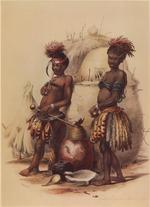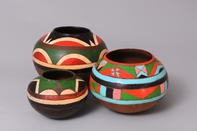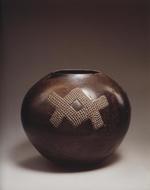
Clay is a versatile material that in the past was used for a variety of purposes, some of which have since fallen away. When the artist, George Angas, visited the Zulu kingdom in 1847, he made sketches of two youths – ‘aristocratic lads, arrayed in their visiting costume’ – surrounded by artefacts that were then commonly used in rural homesteads.
This included items such as grinding stones, spoons fashioned from gourds, and various clay vessels – a small, blackened pot, probably used for serving beer; a milk jar covered with a woven grass lid, presumably with the intention of protecting it from flies and other insects; and a ‘hen-house, built of osiers and plastered over with clay’. Potshards were kept to fry slivers of beef, mutton or goat meat as part of ceremonies associated with the ancestors.

Limpopo Province is home to a vibrant production of pots of various sizes made by women from local Sotho-, Venda- and Tsonga-speaking communities.
Used as both drinking and storage vessels, pots like these have in recent decades commonly been decorated with brightly-coloured enamel paints applied between incised or engraved geometric patterns on the shoulder-rim area of these vessels. Some potters also add more organic engraved motifs such as leaves and flowers.

Several types of pots are produced to this day in rural KwaZulu-Natal, most commonly izinkhamba (sing. ukhamba), which are used for serving beer. There are substantial regional variations in both the size and shape of these vessels.
Those decorated with warts (amasumpa), like the example illustrated here, are still made in the Nongoma-Ondini area where successive 19th century Zulu kings established their royal homesteads.
A smaller version, umancishana, (plural: omancishana) derives its name from ncintshana, ‘to be stingy with, niggardly towards’ someone. Pots like these are also used to serve and eat uphuthu, a maize-based porridge, and amasi, a sour milk delicacy. Izimpiso (sing. uphiso) are small-necked, usually round-bodied, pots.
Because pots such as these are used to transport water or beer, the design of the neck prevents the liquid from spilling. Some potters also specialise in the production of izimbiza (sing. imbiza), which are large storage and brewing vessels sometimes set into the floors of huts as permanent features. Unlike other pots, izimbiza are fired only once before being covered with a slip to which cow dung has been added.
By Professor Sandra Klopper